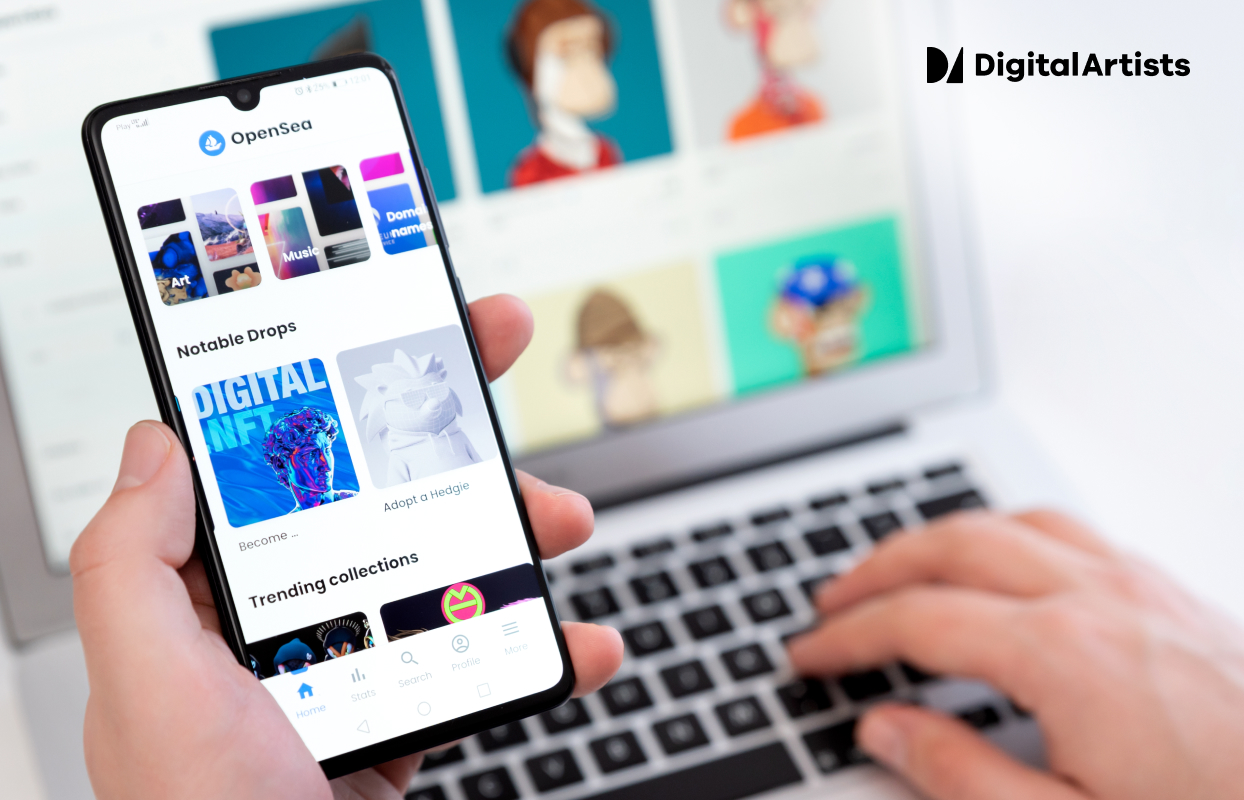


In the rapidly evolving digital landscape, the emergence of Non-Fungible Tokens (NFTs) has revolutionized the concept of collectibles and ownership. These unique digital assets, anchored securely to blockchain technology, represent a tangible or intangible item, making them distinct from every other token. NFT collectibles, encompassing art, music, virtual real estate, and even tweets, have garnered immense attention in the business world. Entrepreneurs, artists, and corporations are increasingly exploring NFTs as a new revenue stream, leveraging their scarcity and verifiable provenance.
The uniqueness of each NFT makes them inherently valuable, comparable to owning a one-of-a-kind piece of art or a rare collectible. As businesses delve deeper into the NFT realm, they’re not only unlocking unprecedented opportunities for brand expansion, fan engagement, and financial growth, but also confronting new challenges associated with digital rights and market volatility. The rise of NFT collectibles underscores a broader shift in the business paradigm, signaling the dawn of an era where the digital and physical realms are more intertwined than ever before.
In today’s digitized world, the boundary between the tangible and the intangible is increasingly blurred. One of the most striking manifestations of this phenomenon is the rise of Non-Fungible Tokens (NFTs) and NFT collectibles. Unlike cryptocurrencies like Bitcoin or Ethereum, which are fungible and interchangeable, NFTs are unique digital assets, each with a distinct value that can’t be replicated. Stored securely on a blockchain, they offer verifiable digital ownership of a wide variety of items—from digital art and music to virtual real estate and even collectible virtual pets.
The world of NFT digital collectibles has expanded the horizons of what we perceive as valuable, democratizing the concept of art and collectibility, and introducing a new layer of value and rarity in the digital realm. The allure of these digital collectibles lies in their singularity and the immutable proof of ownership, making them a sought-after asset for collectors, investors, and digital enthusiasts.
At their core, NFT collectibles function on the principles of blockchain technology—a decentralized ledger that validates and records transactions. When an NFT is created, or ‘minted’, it’s assigned a unique identifier distinguishing it from any other token. This identifier, combined with metadata and often the digital file itself, is stored on the blockchain. Because of the public nature of blockchain, the authenticity and ownership of an NFT can be transparently traced and verified, ensuring its originality and preventing duplication.
When a person buys an NFT collectible, they’re essentially purchasing a digital certificate of authenticity. This certificate grants them ownership, which can be held, sold, or sometimes altered, depending on the NFT’s programmed permissions. Smart contracts can automate certain actions like ensuring the original artist gets a commission every time the NFT is resold. This fusion of art, collectibility, and technology makes NFT collectibles a dynamic force in the digital age, revolutionizing the way we understand and interact with digital assets.
Digital collectibles and NFTs represent distinct categories within the digital asset space. While digital collectibles can encompass a wide range of digital items like virtual trading cards, in-game skins, and virtual pets, NFTs are a specific type of digital collectible with unique properties and ownership records stored on the blockchain. NFTs have gained popularity for their ability to establish true ownership and scarcity of digital assets, making them a valuable innovation in the world of digital collectibles.
On the other hand, NFTs represent a revolutionary step forward in the world of digital ownership. NFTs are tokens on a blockchain that prove ownership of a unique digital item, be it art, music, video, or any other form of content. Unlike traditional digital collectibles, NFTs are decentralized and exist on a blockchain, making them tamper-proof and verifiable. This ensures that ownership is truly in the hands of the holder, independent of any central authority.
In conclusion, when we’re talking about digital collectibles vs NFTs, we can say that both contributing to the world of digital assets, demonstrate NFTs as the pioneers of a secure and decentralized form of ownership, marking a new era in the realm of digital collectibles.
In the dynamic digital era, the advent of Non-Fungible Tokens (NFTs) has reshaped the contours of business, introducing novel avenues for value generation and customer engagement. Beyond the realm of art and gaming, NFT digital collectibles have profound implications for businesses, offering transformative benefits that can redefine traditional operational models.
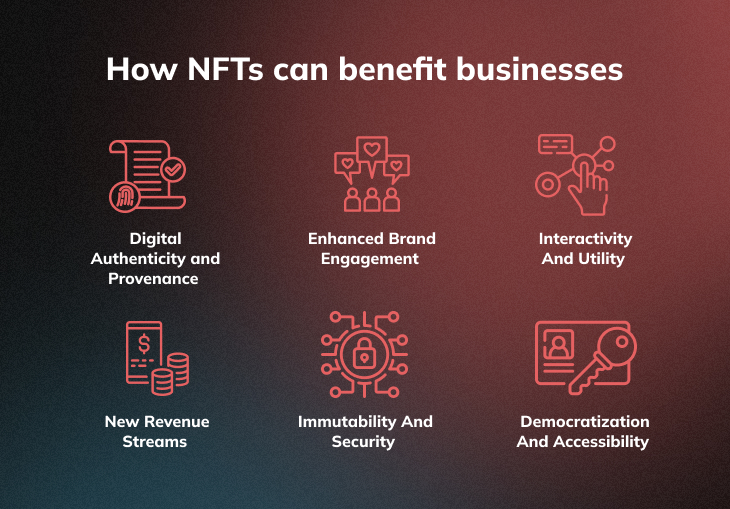
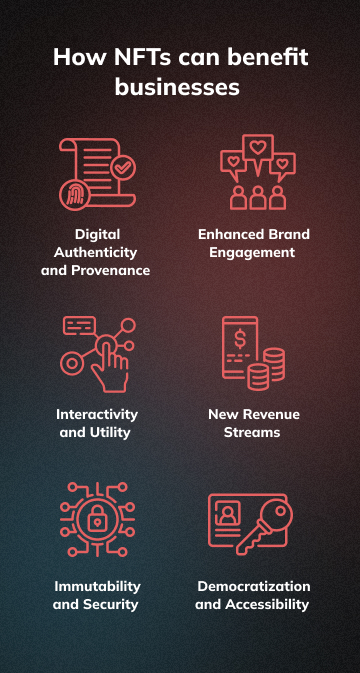
In an age where counterfeiting and replication are rampant, NFTs provide a solution by ensuring digital authenticity. Every NFT has a unique identifier, allowing businesses to verify its origin and ownership. This built-in provenance ensures consumers that they’re purchasing or interacting with genuine digital assets, enhancing trust in the brand and its offerings.
Businesses can tokenize assets, whether they’re digital artworks, exclusive content, or even tangible items linked to a digital token. This tokenization opens up avenues for direct sales, auctions, and limited-edition releases. Moreover, NFTs can be programmed with smart contracts to pay creators a royalty fee with every resale, leading to continuous revenue generation.
NFTs can serve as a powerful tool for brand promotion and engagement. Through limited-edition digital collectibles, exclusive content access, or interactive digital experiences, businesses can foster deeper connections with their audience. This not only amplifies brand loyalty but can also transform customers into brand ambassadors, as they flaunt their exclusive NFT-linked privileges.
One of the inherent properties of NFTs, courtesy of blockchain technology, is their immutability. Once a transaction is recorded or an NFT is minted, the information cannot be altered or deleted. This feature ensures that ownership rights, provenance, and the history of an NFT remain transparent and secure, minimizing fraudulent activities and enhancing consumer trust.
NFTs aren’t just static digital collectibles. They can possess interactivity and utility that can be leveraged in innovative ways. For instance, businesses can issue NFT tickets for events, where ownership of the token grants access to an experience. Similarly, brands can create virtual merchandise, useable within online games or virtual worlds, forging cross-platform partnerships and enhancing user engagement.
Traditional collectibles or art pieces often have barriers to entry, whether it’s their price or limited availability. NFTs can democratize this access. Digital artists from anywhere in the world can tokenize their work and find a global audience. Small businesses can tap into the NFT market just as effectively as large corporations. Additionally, fractional ownership, where multiple users can own ‘shares’ in a single high-value NFT, makes pricier collectibles accessible to a broader audience.
Businesses have long recognized the allure of collectibles as a means to attract, engage, and retain customers. These tangible or intangible items often carry a certain uniqueness, historical significance, or emotional value that people cherish.
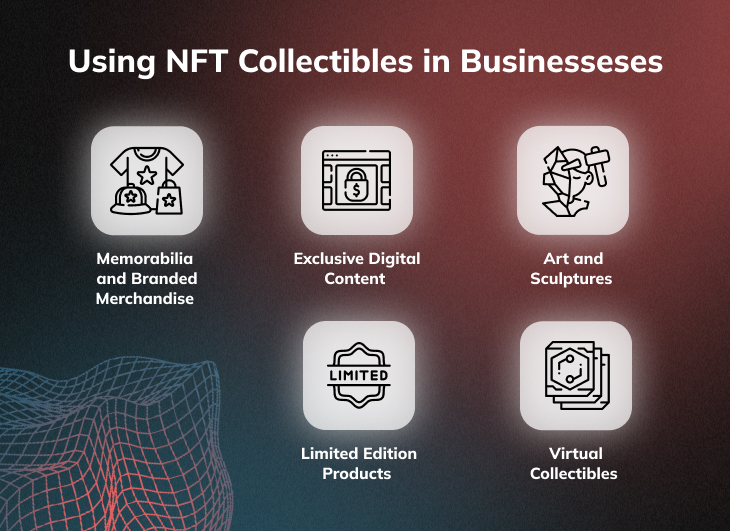
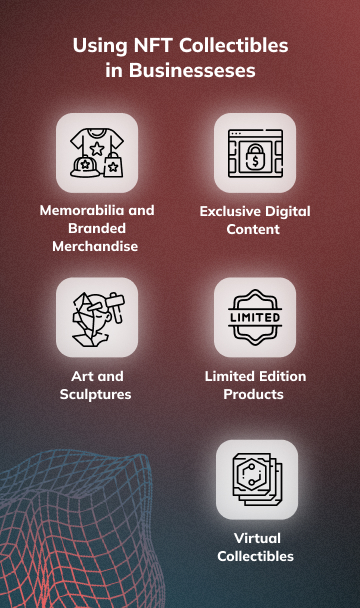
Many businesses, especially those in entertainment, sports, and fashion, release limited edition merchandise. Examples include band t-shirts, autographed sports gear, and designer collaboration pieces. These not only serve as tokens of fandom but also reinforce brand loyalty.
In the digital age, content such as unique video clips, behind-the-scenes footage, or special edition e-books are valuable. For instance, a film studio might release a limited digital collector’s edition of a popular movie with exclusive bonus content.
Corporations, especially luxury brands, might commission artists to create limited edition artworks or sculptures. For instance, car manufacturers like Rolls-Royce have collaborated with artists to produce bespoke art pieces inspired by their vehicles.
Brands often release products in limited quantities to create exclusivity. For instance, Coca-Cola has launched special edition bottles to commemorate events, while tech companies like Apple have released limited color variants of their devices.
With the rise of virtual reality and blockchain technology, digital assets like NFTs are becoming popular. Video game companies, for example, offer in-game skins or characters that players can collect, trade, or sell.
In essence, collectibles in business can range from physical artifacts to digital assets. Their inherent value often lies in their scarcity, exclusivity, or the emotional connection they establish with consumers.
The evolution of the digital frontier has prompted even traditional sectors like news media to innovate and adapt. A testament to this is the growing number of news companies integrating Non-Fungible Tokens (NFTs) into their business models. By tokenizing exclusive stories, iconic photographs, and pivotal moments in journalism, these media houses are not only preserving the indelible mark of history but also opening up novel revenue streams and engagement pathways. This convergence of journalism and blockchain technology underscores the industry’s commitment to staying relevant in a rapidly changing digital landscape.
NBA Top Shot, a groundbreaking partnership between the National Basketball Association and Dapper Labs, has revolutionized the world of sports collectibles by introducing digital assets in the form of NFT sports collectibles. These digital assets consist of “moments” – short video highlights of iconic plays from NBA games.
Mark your Calendars 📌
— NBA Top Shot (@NBATopShot) October 19, 2023
⭐️ Final Origins & Archive Set Packs will drop on 10.24 – followed by their anticipated challenges ✅
🎮 New Leaderboard now live featuring an opportunity to win all 6 new Rare Origins ➡️ https://t.co/GpRQiGirPs pic.twitter.com/7TuwbgcWnX
Unlike traditional sports cards, these digital moments are minted on the Flow blockchain, ensuring each moment’s rarity and authenticity. When purchasing a moment, users can see the exact number of copies in existence, ensuring scarcity. NBA Top Shot offers these moments through pack drops, with each pack containing a selection of moments. Due to high demand, pack drops often lead to frenzied buying, with packs sometimes selling out in mere seconds.
The success of NBA Top Shot lies in its unique combination of sports fandom with the booming interest in digital collectibles. For the NBA, the venture has opened up new monetization avenues, with some moments fetching tens of thousands of dollars, if not more, in the secondary market. Besides the evident financial gains, NBA Top Shot has also ushered in heightened fan engagement, offering a modern take on sports memorabilia and expanding the NBA’s reach into the crypto-savvy demographic.
Larva Labs’ CryptoPunks are among the earliest and most iconic NFTs (non-fungible tokens) on the Ethereum blockchain. Designed as 24×24 pixel art characters, there are exactly 10,000 unique CryptoPunks, each with its distinct features. These pixelated characters range from zombies and apes to various humanoids, with certain traits being rarer than others.
CryptoPunks were initially offered for free to Ethereum users, pioneering the concept of digital collectibles on the blockchain. This altruistic distribution method not only garnered attention but also planted the seeds for the vast NFT ecosystem we see today. As the broader NFT collectibles marketing exploded in popularity, the demand for these original digital collectibles surged, transforming them into highly valuable assets. Some CryptoPunks have sold for millions of dollars.
“Punks have opened more doors for me than my college degree or my prior career…”
— CryptoPunks (@cryptopunksnfts) October 17, 2023
Episode_02 of “Punks As Told By CryptoPunks” is out now. Featuring @ClaireSilver12, CryptoPunk & anonymous AI collaborative artist
In partnership with @nftnow
Watch Now: https://t.co/i68TgASjap pic.twitter.com/KMwvDPnmDE
Larva Labs benefited immensely from this phenomenon. Beyond the direct financial gains from sales (they retained a small number of Punks and also earn a percentage from secondary market trades), CryptoPunks established Larva Labs as visionary leaders in the NFT space. Their success with CryptoPunks has also spawned further innovative projects from the company, solidifying their position as trailblazers in the crypto and digital art world. Their pioneering work has set industry standards and has become a reference point for NFT authenticity and value.
McDonald’s France made a bold move in the realm of digital marketing by integrating Non-Fungible Tokens (NFTs) into their promotional strategies. NFTs are unique digital assets that are blockchain-based, and McDonald’s leveraged their popularity to engage with their customer base in an innovative way.
To issue NFT collectibles, McDonald’s France collaborated with renowned artists creating NFT collectibles which are limited-edition inspired by their iconic menu items and mascots. These digital collectibles were made available through a dedicated platform, often as rewards for customers participating in special promotions or as limited-time offerings. Customers could obtain these NFTs by purchasing specific menu items or participating in social media challenges.
#McDoNFT 09.04.2021 #NFT pic.twitter.com/eOrGyF568y
— McDonald's France (@McDonaldsFrance) April 6, 2021
This strategy proved highly successful for McDonald’s France on several fronts. First, it generated buzz and excitement among their customer base, attracting a younger and tech-savvy audience. Second, it enhanced brand loyalty, as customers sought to complete their NFT collections by visiting McDonald’s outlets repeatedly. Third, the NFTs themselves became digital assets that could appreciate in value, creating a unique investment opportunity for collectors.
By embracing NFTs, McDonald’s France not only capitalized on the growing trend but also diversified its marketing tactics, fostering customer engagement, and establishing itself as a forward-thinking brand. This innovative approach allowed McDonald’s to remain relevant in the ever-evolving digital landscape while reaping the positive benefits of increased customer engagement and loyalty.
Time Magazine, a renowned publication, ventured into the world of Non-Fungible Tokens (NFTs) to adapt to the digital age and enhance its engagement with readers. They introduced NFT collectibles as part of their marketing strategy, merging the traditional with the modern.
Time created exclusive digital artwork and content, such as cover art and historic photographs, which were minted as NFTs on blockchain platforms. These NFTs were often accompanied by unique perks, like access to special Time events or virtual meetings with prominent figures featured in the magazine. Some were sold in limited editions, creating scarcity and value for collectors.
This strategy worked exceptionally well for Time Magazine. Firstly, it attracted a new and tech-savvy audience, expanding their readership. Secondly, it capitalized on the growing NFT trend, tapping into a market hungry for digital collectibles. Thirdly, it monetized their rich archive of historical content in a novel way.
Moreover, NFTs allowed Time to reinforce its brand’s image as a forward-thinking and innovative publication. It provided a new revenue stream while maintaining their presence in the digital landscape. By embracing NFTs, Time Magazine successfully blended tradition with innovation, leveraging the benefits of blockchain technology to engage readers and secure its place in the digital era.
Ubisoft Quartz, an extension of the renowned video game developer Ubisoft, embarked on a groundbreaking journey by incorporating Non-Fungible Tokens (NFTs) into their gaming strategies. This initiative aimed to bridge the gap between the gaming and blockchain worlds.
Ubisoft Quartz introduced NFT collectibles within their games, allowing players to own and trade unique in-game items and characters as NFTs on the blockchain. These digital assets had varying degrees of rarity, and some could be earned through in-game achievements, while others were available through limited-time events or purchases.
The strategy proved to be highly successful for Ubisoft Quartz. It increased player engagement by adding an extra layer of excitement and value to their gaming experiences. Players could now truly own their in-game items and potentially profit from them by trading on NFT marketplaces.
Furthermore, Ubisoft Quartz fostered a sense of community among players who enjoyed collecting and trading NFTs, creating a loyal and active player base. Additionally, it offered a new revenue stream for the company, as players were willing to spend real money to acquire rare NFTs.
In summary, Ubisoft Quartz’s integration of NFT collectibles into their games not only enhanced player engagement and community building but also generated a new source of income. It showcased the potential for NFTs to transform the gaming industry by providing players with true ownership of their digital assets and opening up exciting opportunities for both gamers and developers.
Beeple‘s “Everydays: The First 5000 Days” is a groundbreaking digital art collection that made waves in the world of NFTs (Non-Fungible Tokens). Created by the digital artist Mike Winkelmann, known as Beeple, this collection comprised 5,000 unique digital artworks created over 13 years. Beeple adopted an innovative strategy to issue NFT collectibles, setting a new standard in the art world.
To issue NFT collectables, Beeple auctioned “Everydays” as a single NFT on Christie’s, one of the world’s leading auction houses. This auction format was unprecedented for a digital artist and garnered massive attention. The winning bidder received the entire collection as a single NFT, a historic moment that marked Beeple’s groundbreaking foray into the art establishment.
This strategy worked brilliantly for Beeple. It demonstrated the potential of NFTs to redefine ownership in the art world and brought immense publicity not only to Beeple but also to the NFT ecosystem. The sale of “Everydays” for a staggering $69.3 million established Beeple as one of the most influential digital artists and validated the value of digital art in the NFT market.
The positives for Beeple included not only substantial financial gains but also the establishment of his legacy as a pioneer in the NFT art movement. His success served as a catalyst for other artists to explore NFTs, further legitimizing digital art in the traditional art world and expanding the possibilities for creators in the digital space.
The future of NFT (Non-Fungible Token) collectibles is a landscape filled with immense potential and transformational possibilities. As we look ahead, several key trends and developments are shaping the trajectory of NFT collectibles.
NFTs are poised to diversify their use cases significantly. While they initially gained popularity in the art and gaming sectors, they are increasingly finding applications in various industries. NFTs will play a pivotal role in the tokenization of real-world assets, such as real estate, allowing for more accessible and liquid ownership. Moreover, they will be instrumental in verifying the authenticity and provenance of rare physical items, such as luxury goods and historical artifacts.
In addition, the top NFT collectibles in the digital art world are fetching astronomical prices at auction, underscoring their growing influence in the art market and beyond.
NFT ecosystems are expected to become more interconnected and interoperable. This means that NFTs will seamlessly move across different platforms and blockchains, fostering a more fluid and interconnected NFT economy. As standards for cross-platform compatibility emerge, users will experience greater freedom and flexibility in managing their NFT collections.
Environmental sustainability is another significant aspect of the NFT collectible future. The environmental impact of blockchain networks, particularly those using energy-intensive Proof-of-Work (PoW) consensus mechanisms, has drawn criticism. Consequently, NFT platforms are increasingly transitioning to more eco-friendly Proof-of-Stake (PoS) systems or layer-2 solutions to mitigate their carbon footprint. Sustainability considerations will continue to influence the design and operation of NFT ecosystems.
NFT collectibles are expected to integrate deeper into mainstream culture. Celebrities, musicians, and athletes are already leveraging NFTs to connect with their fan base and monetize their digital assets. This trend is likely to intensify as more public figures and brands explore the possibilities of NFTs for marketing, fan engagement, and content distribution.
In conclusion, the future of NFT collectibles is marked by expansion, interconnectivity, sustainability, and mainstream adoption. As NFT technology matures and permeates various industries, its transformative potential will continue to reshape how we perceive and interact with digital and physical assets.
Welcome to the FAQs section on NFT (Non-Fungible Token) collectibles in business. Here, we address common questions and concerns surrounding the integration of NFTs into the corporate landscape. Explore the evolving world of digital assets and discover how NFTs are reshaping industries and unlocking new opportunities for businesses.
A Non-Fungible Token (NFT) collectible is a unique, blockchain-based digital asset that represents ownership of a specific item, artwork, or digital content. Unlike cryptocurrencies, NFTs are indivisible and cannot be exchanged on a one-to-one basis due to their distinct, non-interchangeable characteristics, making them ideal for verifying authenticity and ownership of digital or physical assets.
The primary difference between NFTs (Non-Fungible Tokens) and traditional collectibles lies in their digital nature and uniqueness. Collectibles, like physical trading cards or vintage toys, exist in the physical world and can be replicated. NFTs, on the other hand, are purely digital and represent unique ownership of digital or physical assets. NFTs are indivisible and stored on a blockchain, making them tamper-proof and allowing for easy verification of authenticity. Collectibles, while valuable, lack the inherent scarcity and immutability of NFTs, making NFTs a revolutionary innovation in verifying and owning digital or physical items in the digital age.
Collectible NFTs (Non-Fungible Tokens) work by leveraging blockchain technology to represent ownership of unique digital or physical assets. Each NFT is associated with a specific item, artwork, or piece of content and is recorded on a blockchain, which is a decentralized and secure digital ledger. This blockchain entry verifies the authenticity, ownership, and history of the collectible. Owners can buy, sell, or trade these NFTs on various online marketplaces. Smart contracts embedded in NFTs can also automate royalty payments to creators when the collectible changes hands. Collectible NFTs are indivisible, making each one truly one-of-a-kind and valuable to collectors and creators alike.